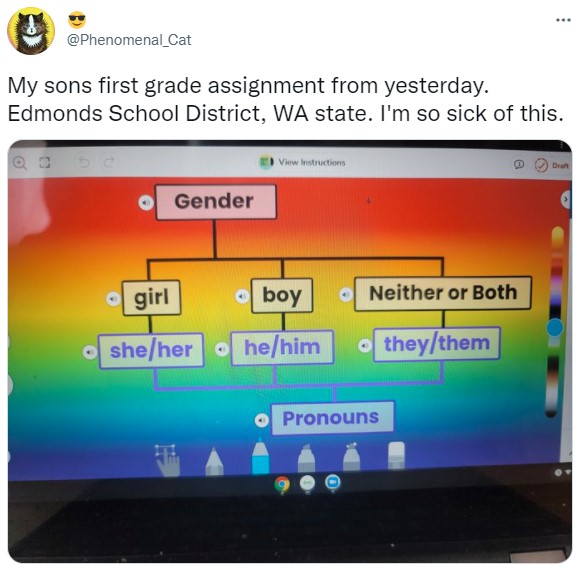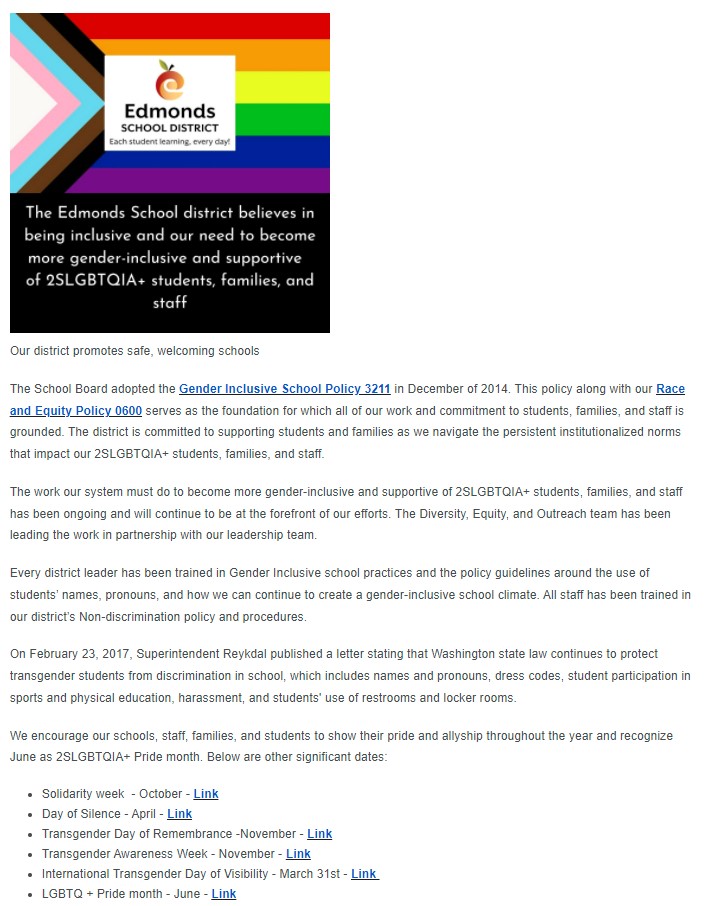
Edmonds School District teaches children in first grade that there are more than two genders; encourages students to pick their preferred pronouns
Incidents
- Issues
- Indoctrination
- Sex and Gender
A parent on Twitter posted images of the material that Edmonds School District is teaching children in the first grade. In a lesson taught to first graders, an image is shown that separates “gender” into three categories that are “girl,” “boy,” and “neither or both.” The image then explains the pronouns to use with each gender. Under the “neither or both” category, the image explains to use “they/them” pronouns.

The parent then posted other images on Twitter from lessons that the school district taught first graders. One assignment told students to “create a snowperson that is an example of how you identify yourself.” Another image featured the book They, She, He, Me: Free to Be! The book explains to children and parents how to use the preferred pronouns of others.

KTTH also reported on what the school district is teaching young children. The news outlet explained that a “district spokesperson argues the lesson plan is mandated by the state,” but the school district still “goes above and beyond what state law requires.” The outlet additionally reported that the school district “refuses to disclose the full curriculum to the public.” KTTH explains:
The Edmonds School District developed lesson plans on self-identity that includes the claim that sometimes, gender does not exist. Other times, a person can have two genders. First graders learn about the “nonbinary experience” and teachers are told to ask students to list their gender identities so that “gender nonconforming” students can feel more comfortable.
KTTH further explains that the topic of gender identity is not meant to be taught in the state of Washington until “fourth grade.” However, the school district still “pushed the lesson plan on the kids” in the “online portal.” The school district also promotes the book Jamie and Bubble: A Book About People’s Pronouns. KTTH explains that the book “focuses on a woke child teaching a grandmother that you shouldn’t assume someone’s gender.” These topics are not just limited to lessons in grammar, but are integrated into other classes including physical education and health.
KTTH also explains that the news outlet reached out to the school district’s spokesperson who has her pronouns of “she/her” listed in her email signature. The spokesperson explained that the lessons were based on the state’s mandated health standards for schools: “Teachers use the standards to design lessons to provide a variety of age-appropriate and grade-level learning.”
In a statement, the school district also explained why it was teaching children about gender identity and pronouns:
The Edmonds School District is required to teach state standards. One component of the Washington State Health Education Standards includes a section on self identity. It also includes sections on healthy relationships, growth and development, wellness, safety, as well as other areas.
The school district has a page on its website labeled “2SLGBTQIA+ Inclusivity.” The page states that the school district encourages “our schools, staff, families, and students to show their pride and allyship throughout the year and recognize June as 2SLGBTQIA+ Pride month.” The school district then lists significant dates to celebrate, including “Transgender Day of Remembrance,” “International Transgender Day of Visibility,” and “Transgender Awareness Week.” The page also features several resources for children who identify as transgender.

The school district also adopted a “Gender-Inclusive Schools” policy in December 2014. The policy specifically mentions “gender expression,” “gender identity,” and “sex.” The policy explains:
To that end, the board recognizes the importance of an inclusive approach toward transgender and gender-expansive students with regard to key terms, communication and the use of names and pronouns, student records, confidential health and education information, communication, restroom and locker room use and accessibility, sports and physical education, dress codes, and other school activities, in order to provide these students with an equal opportunity for learning and achievement.
Stay Informed
